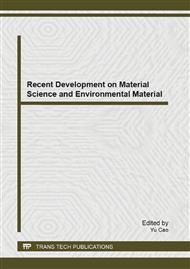[1]
Zheng Chuguang, Zhang Junying, Zhao Yongchun, Emission and control of mercury from coal combustion[M]. Beijing: Science Press, (2010).
Google Scholar
[2]
Wang Qichao, Shen Wenguo, Ma Zhuangwei. Estimation of mercury emission from coal combustion in China[J]. Environmental Science of China, 1999, 194(4): 318-321.
Google Scholar
[3]
Jang Jingkun, Hao Jiming, Wu Ye, Preliminary establishment of mercury emission inventory from coal combustion in China[J]. Environmental Science, 2005, 26(2): 34-39.
Google Scholar
[4]
Senior C L, Helble J J, Sarofim A F. Emissions of mercury, trace elements, and fine particles from stationary combustion sources[J]. Fuel Processing Technology, 2000, 65: 263-288.
DOI: 10.1016/s0378-3820(00)00082-5
Google Scholar
[5]
Zheng Chuguang, Xu Minghou, Zhang Junying, Emission and control of trace elements in coal[J]. Wuhan: Hubei science and Technology Press. 2002: 82-83.
Google Scholar
[6]
Topical Report No. 5 Trace Element Removal Study. Prepared for U S Department of Energy'S Pittsburgh Technology Center by ICF Kaiser Engineers, Fairfax and VA. March (1995).
Google Scholar
[7]
Minghou Xu, Kinetic Calculation and Modeling of Trace Element Reactions during Combustion[J], Powder Technology, 180(2008): 157-160.
DOI: 10.1016/j.powtec.2007.03.047
Google Scholar
[8]
M. Antonia Lopez-Anton, Juan M.D. Tanscon, M. Rosa Martinez-Tarazona. Retention of mercury in activated carbons in coal combustion and gasification flue gases[J]. Fuel Processing Technology, 2002, 77(8): 353~357.
DOI: 10.1016/s0378-3820(02)00054-1
Google Scholar
[9]
Carey T R, Hargrove Jr OW, Richardson C F, et al. Factors affecting mercury control in utility flue gas using activated carbon. Journal of the Air&Waste Management Association, 1998, 48(12): 1166~1174.
DOI: 10.1080/10473289.1998.10463753
Google Scholar
[10]
Wang Guangkai, Study on the stability of mercury mercury products and removal of mercury emissions from coal-fired power plant[D]. Zhejiang University, 2006: 8.
Google Scholar
[11]
Serre SD, Silcox GD. Adsorption of elemental mercury on the residual carbon in coal fly ash[C]. Ind Eng Chem Res 2000; 39: 1723~1730.
DOI: 10.1021/ie990680i
Google Scholar
[12]
Senior CL, Johnson SA, Impact of carbon-in-ash on mercury removal across particulate control devices in coal-fired power plants[J]. Energy Fuels 2005; 19: 859~867.
DOI: 10.1021/ef049861+
Google Scholar
[13]
Owens W, Sarofim A, Pershing D, The use of recycle for enhanced volatile metal capture. Fuel Processing Technology, 1994, 39(1~3): 337~356.
DOI: 10.1016/0378-3820(94)90191-0
Google Scholar
[14]
Huggins F E, Yap N, Huffman G P, etal. XAFS characterization of mercury captured from combustion gases on sorbents at low temperatures. Fuel Processing Technology, 2003, 82(2-3): 167~196.
DOI: 10.1016/s0378-3820(03)00068-7
Google Scholar
[15]
Li Y H, Lee C W, Gullett B K, Importance of activated carbon'soxygen surface functional groups on elemental mercury adsorption. Fuel, 2003, 82(4): 451~457.
DOI: 10.1016/s0016-2361(02)00307-1
Google Scholar
[16]
Li Anmo, Wei Jizhong, Analysis of atomic absorption and atomic fluorescence spectrometry[M]. Beijing: Science Press, (2000).
Google Scholar
[17]
Zhao Zaofan, Instrumental analysis[M]. Beijing: Higher Education Press, (1990).
Google Scholar


